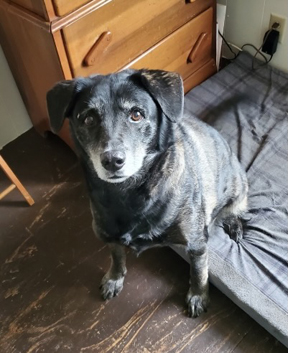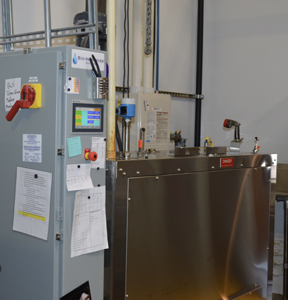An alternative to burial or cremation, the method involves dissolving bodies with water
Sarge Sammy Salazar

Photo courtesy of Salvador "Bo" Salazar Jr.
After 12 years as a service dog to a military veteran, Sarge Sammy Salazar died last month at age 13. His owner opted to have Sarge's body "aquamated," an increasingly available alternative to burial and cremation.
Dr. Daniel Annin asked his partner four years ago to buy out his share of their veterinary practice in Omaha, Nebraska, so that he could dedicate more time to his deceased patients.
While Annin still cares for living patients part-time, his primary focus now is Eco Animal Cremation, an enterprise offering aquamation. Technically called alkaline hydrolysis, the process involves dissolving bodies of the deceased in water.
Annin and others describe aquamation as an increasingly popular alternative to conventional burial and cremation, and say it is better for the environment because it has a relatively small carbon footprint.
When the business started in 2017, Annin said only a minority of veterinary clinics were educated and knowledgeable about aquamation. "It wasn't near as mainstream or talked about," he said. Now, he said, "We do a least a quarter of the cremations in Omaha," which translates to after-death care for more than 6,000 individuals per year. (Providers call aquamation "water cremation.")
Annin exemplifies the unique role veterinarians play in death care. While human health care is typically separated from the funeral industry and disposition of the body, veterinarians are expected to care for living patients and also coordinate the handling of the remains of those who have died.
More than 85% of about 2,000 dog and cat owners surveyed for a study published in June said they were somewhat or extremely likely to use information from veterinary teams on pet dying, after-death body care and memorialization.
Poul Lemasters, a funeral director and attorney based in Cincinnati, said it's hard to imagine a physician offering a patient's loved ones options for disposition of the body. "And yet, in the world of vets, we do it all the time," he said.
End-of-life choices are emotional and can be fraught with miscommunication. For that reason, Lemasters, who offers consulting services in death care for people and pets alike, recommends that veterinarians educate clients about all possible options for body handling.
The authors of the study published in June, including Dr. Kathleen Cooney, director of education at the Companion Animal Euthanasia Training Academy in Colorado, agree. "Owners who are not informed of their options may feel angry or believe they missed out on the opportunity to choose the ideal way to memorialize their pet," they write.
Alternatives to traditional burial and cremation include new approaches such as aquamation and composting; and more established niche practices such as freeze-drying, a means of preserving the body similar to taxidermy; and sky burial.
Aquamation gains interest
In a business park in Bellingham, Washington, the low hum of a flame-based cremation system for animals carries through the wall of Radiant Heart, a funeral home for pets. In the same room as the conventional crematory, an aquamation machine holding the bodies of eight pets is barely audible.
Bobbie Ruth Langley, co-founder of Radiant Heart, said she offered only cremation when she first opened the business in 2013. She learned about aquamation from a 2017 news story on a provider elsewhere in the state. Langley was immediately drawn to what she saw as a gentle, discreet and environmentally friendly way of hastening natural decomposition; she decided to expand her offerings.
"I was never super-happy with flame cremation because of all the natural gas it uses and the CO2 it generates," Langley said, referring to carbon dioxide and its role as a climate-changing greenhouse gas. "People here [in Bellingham] are very ecologically oriented; they want to do things that are good for the environment, and so right off the bat — I would say overnight — our business went from 100% flame to 50-50."
Overall, aquamation accounts for a very small proportion of methods chosen by pet owners for body disposition. The survey by Cooney and colleagues found that just under 2% of 2,031 respondents identified alkaline hydrolysis as their preferred after-death body care option. Burial (individually at home or in a cemetery, or en masse) was the most-selected option, by 48% of respondents, followed by cremation at 40% and body donation at 3%.
But interest in aquamation is spreading. Samantha Sieber, vice president of research at Bio-Response Solutions, an aquamation equipment company in Danville, Indiana, said sales in the U.S. have increased steadily during the past decade. She said more than half of the company's business is overseas, with buyers of aquamation equipment for pets in Australia, France, Germany, Guam, Hong Kong, Malaysia, the Netherlands and Singapore. Sieber said 15% to 20% of Bio-Response Solutions machines are owned by veterinary professionals.
Like Langley, Salvador "Bo" Salazar Jr. was drawn to aquamation's eco-friendliness when he selected the method to handle the body of his German shepherd, Sarge Sammy Salazar. A 38-year-old military veteran in Lecanto, Florida, Salazar began doing research on after-death care when Sarge, his service dog for 12 years, became gravely ill last month. Salazar said aquamation, besides being easy on the environment, seemed gentle on the body and enabled him to keep Sarge's remains separate from others'.
"The vet I used would always recommend the same crematory place, and I didn't have a good feeling about it," Salazar said. "There's places that'll cremate more than one animal at a time, and you don't really know [what's in the ashes]." He didn't want that for Sarge. "He was everything to me," Salazar said.
How it works
Aquamation machine

VIN News Service photo
An aquamation machine at Radiant Heart in Washington state holds the bodies of eight pets in individual compartments undergoing alkaline hydrolysis, a process that speeds decomposition. The structure at left houses the control panel.
Multiple aquamation providers interviewed for this story describe the process this way: The body is placed inside a compartment in a stainless steel machine in which liquid heated to 200-or-so degrees Fahrenheit circulates around the body. The liquid is composed of 95% water and 5% alkali, which breaks down organic tissue.
The water used per individual is equivalent to about two baths. The equipment requires only access to hot and cold water, a discharge line and a dry line, similar to hookups needed to operate a washer and dryer.
Cooney, who founded (and recently sold) an aquamation business in Loveland, Colorado, said that in her experience, the Bio-Response machines she used consumed minimal water. She said two machines, which together could process up to 700 pounds in remains, used no more than 400 gallons of water a day total, roughly equivalent to the amount used by a four-person household. She called her water bill "an extremely negligible blip."
The process does consume a significant amount of electricity, Cooney added, to run two alkaline hydrolysis machines, a cooler, dehumidifier and water heater.
The process takes 16 to 24 hours. What remains afterward are bones and effluent, the latter a sterile liquid containing organic compounds, and devoid of DNA. Some aquamation services save the effluent for use as fertilizer; some let it go down the drain, although not all jurisdictions allow that.
The bones usually are ground into a powder and returned to the pet's families, like ashes after a cremation. Unlike cremation, the bones may be examined to determine cause of death or nature of death before grinding, if desired, Cooney said.
"Aquamation provides an opportunity to do some detective work with regards to bone cancer [or] any sort of bone pathology — we can identify some of those changes rather readily," Cooney explained. "When we open up the machine and look inside, and there's the skeleton, it's relatively easy to identify bone pathology, and that might not be the case with flame."
The aquamation process breaks down protein but not foreign bodies that cremation might destroy. Peach pits, corn cobs, plastic and other such materials ingested by the pet would be left behind, potentially helping to identify cause of death.
Compared with cremation, aquamation has about one-tenth the carbon footprint, Sieber said, citing a life-cycle analysis. To date, permitting, environmental and zoning regulations are negligible in the U.S. Regulation of pet aquamation itself is in a liminal state: While aquamation is legal for human bodies in 22 states, laws are largely silent on its use for companion animals.
"On the pet side, there's hardly any regulation on it at all," Lemasters said. "I don't know about any state that says you can't use alkaline hydrolysis, but there's not a law in every state that says you can do it."
There are no restrictions on who can buy an aquamation machine, which at Bio-Response are priced from $60,000 (sized to accommodate a single pet) to $200,000 (able to hold bodies weighing 4,000 pounds in total). In general, the price to "aquamate" a deceased companion animal runs from $129 to $300, depending on its size.
Other approaches to body disposition
Natural organic reduction, or composting, emerged as a potential end-of-life care option for pets when it was legalized for humans in Washington state in 2019. Colorado and Oregon have since followed, and similar legislation is pending in California.
Composting the bodies of livestock and other large animals has been done on rural private property for years, but it's new for urban and suburban household pets. Entrepreneur Paul Tschetter brought the concept to Tenino, Washington, in 2019 with the opening of Rooted Pet.
The process involves placing the body in a 3-foot-by-3-foot polyurethane pod, hooking the pod to an aeration system, and adding a proprietary agent to speed decomposition. After about 60 days, what's left is a bucket of soil, which owners may use to plant a tree.
When it opened, Rooted Pet charged $50 to $100 per pet. Tschetter has since found that he can't cover his overhead by charging what the market will bear.
"Human composters are charging $5,000 per human — this is a new service, they're charging a bit of a premium," he said. "We can do a 100-pound dog, and the most people will pay is a couple hundred bucks. From a sustainability standpoint, the market isn't really realistic." Consequently, Tschetter is exploring other business models for providing the service.
Another way of handling remains involves deliberately placing the body outdoors, unburied, to be exposed to nature's elements. The method is called sky burial, after a practice followed by some cultures in Asia in which a human corpse is taken to a mountaintop to naturally decompose or be scavenged by animals. Cooney noted that the method is unsafe if the animal has been euthanized because euthanasia drugs in the animal's system can harm wildlife that feed on the body. In 2015 in Marion County, Florida, two bald eagles reportedly required emergency treatment after consuming the bodies of improperly disposed euthanized pets.
The U.S. Fish & Wildlife Service provides recommendations on avoiding this sort of poisoning. The fine for harming a protected species such as a bald eagle can be as much as $25,000.
Coleen Ellis, a pet-loss consultant based in Texas, believes that providing resources and education on options for body disposition are essential for a strong veterinarian-client-patient relationship. "Whatever is chosen as the final arrangement, I want to make sure that families have enough education and information that when they make the decision, the choice is right for them," Ellis said.